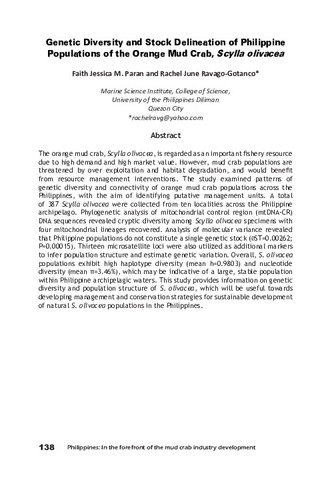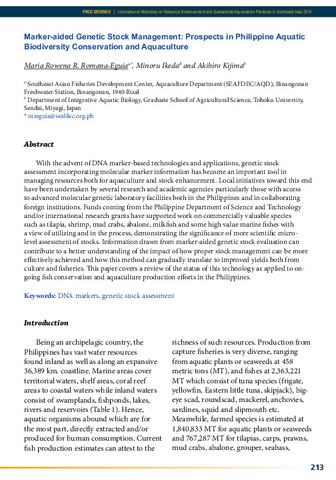Genetic diversity and stock delineation of Philippine populations of the orange mud crab, Scylla olivacea
Share
trừu tượng
The orange mud crab, Scylla olivacea, is regarded as an important fishery resource due to high demand and high market value. However, mud crab populations are threatened by over exploitation and habitat degradation, and would benefit from resource management interventions. The study examined patterns of genetic diversity and connectivity of orange mud crab populations across the Philippines, with the aim of identifying putative management units. A total of 387 Scylla olivacea were collected from ten localities across the Philippine archipelago. Phylogenetic analysis of mitochondrial control region (mtDNA-CR) DNA sequences revealed cryptic diversity among Scylla olivacea specimens with four mitochondrial lineages recovered. Analysis of molecular variance revealed that Philippine populations do not constitute a single genetic stock (0ST=0.00262; P=0.00015). Thirteen microsatellite loci were also utilized as additional markers to infer population structure and estimate genetic variation. Overall, S. olivacea populations exhibit high haplotype diversity (mean h=0.9803) and nucleotide diversity (mean ~p3.46%), which may be indicative of a large, stable population within Philippine archipelagic waters. This study provides information on genetic diversity and population structure of S. olivacea, which will be useful towards developing management and conservation strategies for sustainable development of natural S. olivacea populations in the Philippines.
Sự miêu tả
Abstract only.
Suggested Citation
Paran, F. J. M., & Ravago-Gotanco, R. J. (2017). Genetic diversity and stock delineation of Philippine populations of the orange mud crab, Scylla olivacea. In E. T. Quinitio, F. D. Parado-Estepa, & R. M. Coloso (Eds.), Philippines : In the forefront of the mud crab industry development : proceedings of the 1st National Mud Crab Congress, 16-18 November 2015, Iloilo City, Philippines (p. 138). Tigbauan, Iloilo, Philippines: Aquaculture Department, Southeast Asian Fisheries Development Center.
Chủ thể
Related items
Showing items related by title, author, creator and subject.
-
Genetic assessment of philippine milkfish (Chanos chanos) stocks based on novel microsatellites for markeraided broodstock management
Romana-Eguia, Maria Rowena R.; Santos, Brian S.; Ikeda, Minoru; Basiao, Zubaida U.; de Jesus-Ayson, Evelyn Grace T.; Kijima, Akihiro (Elsevier, 2017)Reports on genetic diversity within/among milkfish populations using DNA markers are sparse. Earlier work dealt with evolutionary relationships among wild populations to define management units in the Indo-Pacific region ... -
Marker-aided genetic stock management: prospects in Philippine aquatic biodiversity conservation and aquaculture
Romana-Eguia, Maria Rowena R.; Ikeda, Minoru; Kijima, Akihiro (Aquaculture Department, Southeast Asian Fisheries Development Center, 2015)With the advent of DNA marker-based technologies and applications, genetic stock assessment incorporating molecular marker information has become an important tool in managing resources both for aquaculture and stock ... -
Selective diversification of aquaculture stocks: A proposal for economically sustainable genetic conservation
Doyle, R. W.; Shackel, N. L.; Basiao, Zubaida; Uraiwan, S.; Matricia, T.; Talbot, A. J. (NRC Research Press, 1991)The genetic diversity of aquaculture stocks can be maintained, and their genetic impact on wild stocks minimized, by breeding programmes that deliberately generate genetic diversity. Current animal breeding practices are ...





